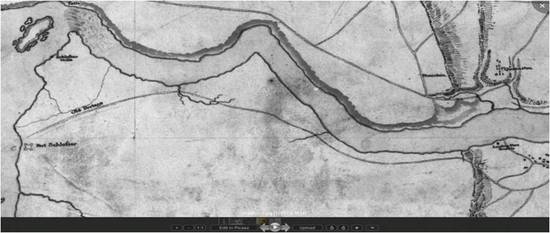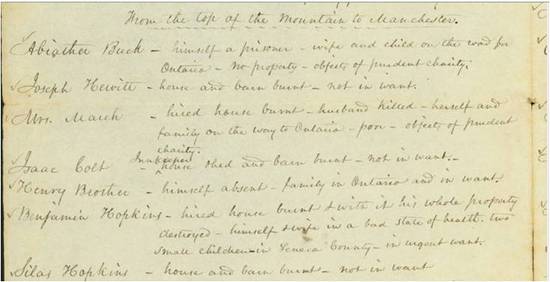By Michelle Ann Kratts

[1814] Plan of Niagara Frontier
Showing the portage and Fort Schlosser
Map source: Library and Archives Canada, NMC 26862.
Oakwood Cemetery’s brush with the War of 1812 is manifold. First of all, located alongside the famous Portage Road, Oakwood lies on a path of historical significance. The ancient portage, a route between the lower and upper Niagara River, had first been laid out by the Native Americans as a clearing through the woods. The French found it a very convenient route to utilize for their fur trading operations. John Stedman enlarged the clearing at the upper end and made another clearing on the mainland opposite Goat Island. The English built blockade houses along the pathway and enlarged the road which allowed for their wagons to get through. Many famous men and women from our history have gone down this road. They often ended up at the Stedman house—warming their hands before the Old Stone Chimney. Soldiers came through this road quite often as it linked up Fort Niagara and Fort Schlosser—two very important sites during the War of 1812.

Sketch by Col. Peter A. Porter of the Old Stone Chimney, one of the only structures to remain after the burning of Manchester and Schlosser
PICTORIAL FIELD-BOOK OF THE WAR OF 1812, BY BENSON J. LOSSING, 1869
And, of course, Oakwood carries the remains of many veterans of the War of 1812, including the man who reported the actual resolutions for the declaration of war to Congress, General Peter B. Porter. But also entombed within Oakwood’s gates are the souls of countless individuals who experienced the great suffering of this period first-hand—men and women from both sides of the conflict. Oakwood will celebrate the lives of these men and women in a series of stories beginning this week with the commemoration of the burning of the Niagara frontier which began on December 19, 1813. This year marks two hundred years since one of the most violent assaults upon this area was delivered.

General Peter B. Porter
The present city of Niagara Falls was along the path of destruction—which passed right before what is now Oakwood Cemetery. It is unknown if there was any sort of structure during this time on the cemetery grounds—however it is undeniable that the road outside the gates was much travelled upon during the war. Most of the area from the top of the mountain (which is now the borderlands of Niagara Falls and Lewiston) from the area known as Manchester to the upper landing at Fort Schlosser was devastated. Dozens of buildings were razed and men, women and children left to flee the fires and the violence in the bitter winter elements. The following list contains “the sufferers” or those who lost property or family members on the Niagara Frontier during the War and filed claims with the government. Many fled to Genesee County or other areas close-by. Some returned around 1816 to rebuild. This list provides names of individuals and families as well as a description of dwellings that had been standing prior to the burning. These are the losses experienced in the present city of Niagara Falls—when all of the world seemed to be on fire. Many of these individuals are buried in Oakwood Cemetery.

List of Sufferers on the Niagara Frontier from Fort Niagara to the Tonewanta Creek
and from Lewiston on the Ridge Road to the Widow Forsythe’s
Courtesy Buffalo History Museum
New York Heritage Digital Collections
From the top of the mountain to Manchester
Abiather Buck—Himself a prisoner; wife and child on the road for Ontario; no property; they are objects of prudent charity
Joseph Hewitt—House and barn burnt, not in want
Mrs. March-- Hired house burnt; husband killed; herself and family on the way to Ontario; poor; objects of prudent charity
Isaac Colt—Innkeeper; house, shed and barn burnt; not in want
Henry Brother—Himself absent; family in Ontario and in want
Benjamin Hopkins—Hired house burnt and with it his whole property destroyed; himself and wife in a sad state of health; two small children; in Seneca County, in urgent want
Silas Hopkins—House and barn burnt; not in want
Ephraim Hopkins—Hired house burnt; supposed to have lost nothing; not in want
Dr. Park—Elderly infirm man; large family; house and barn burnt; himself and family now in Newtown; supposed to be in urgent want
James Murray—Hired house burnt; wife and small family in Utica, himself in Niagara County; supposed to be in want
Jacob Hovey—Small family; house, etc. burnt; carpenter
Ebenezer Hovey—House etc. burnt; also carpenter; both with their families supposed to be in Canandaigua; present circumstances not actually known; worthy men
Gad Pierce—House etc. burnt; large family in Genesee County; not in want
Manchester
Mrs. Armington—House burnt; husband died about a year since; in Ontario presumed to be in want
--Raymond—Blacksmith; lived in part of a hired house; had been there but a short time, could not have lost much; present circumstances and residence unknown; family himself and wife
John Davids—Wheelwright; hired house etc. burnt; circumstances as to residence etc. much the same as Raymond’s
Ralph Coffin—Lost everything or nearly so; respectable family, five children; moved two or three times in consequence of the war; now near Batavia; people that have seen better times; presumed to be in urgent want (a bookkeeper for Judge Porter)
Joshua Fairchild—Innkeeper; house etc. burnt; residence unknown; an object of prudent charity
Oliver Udall—Hired house burnt; saved all his property—so much so as to be supposed not to have lost a dollar’s worth; in Ontario County
Parkhurst Whitney—Hired house burnt; small family presumed to be in want; residence Cayuga or Seneca County
John W. Stoughton—House, tailor’s-shop, fulling-mill and carding machine burnt; lost his all; a worthy man, presumed to be in want; residence Batavia
John Sims—Hired house burn; poor and presumed to be in want; residence in Genesee county
Augustus Porter—A great sufferer
William Chapman—Rope maker; house burnt, lost his all; worthy man, formerly of New York; present residence of himself and family unknown
Schlosser
Asa Fuller—Innkeeper; hired house etc., burnt; small family; presumed not to be in want
Warren Sadler—Loss unknown; presumed not to be in want
From Schlosser to Tonewanta
Mrs. Evingham—Lost her husband about a year since; house and barn burnt; three children; presumed to be in want
James Field—Innkeeper; house and barn burnt; a large family; presumed to be in want; residence Genesee County
Jacob Gilbert—House etc. burnt; not in want
--Hayford, --Rogers—Loss unknown, wants and residence unknown; had lately come from Canada
George Burgar—House etc. burnt; presumed to be in want
--Vanslyck—At Tonewanta Bridge; log house, etc. destroyed